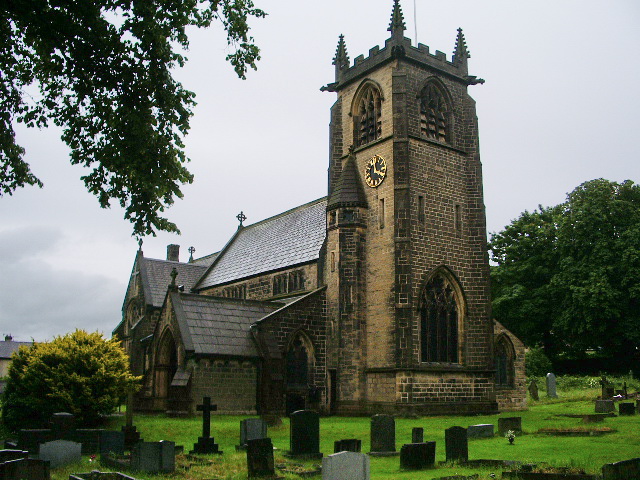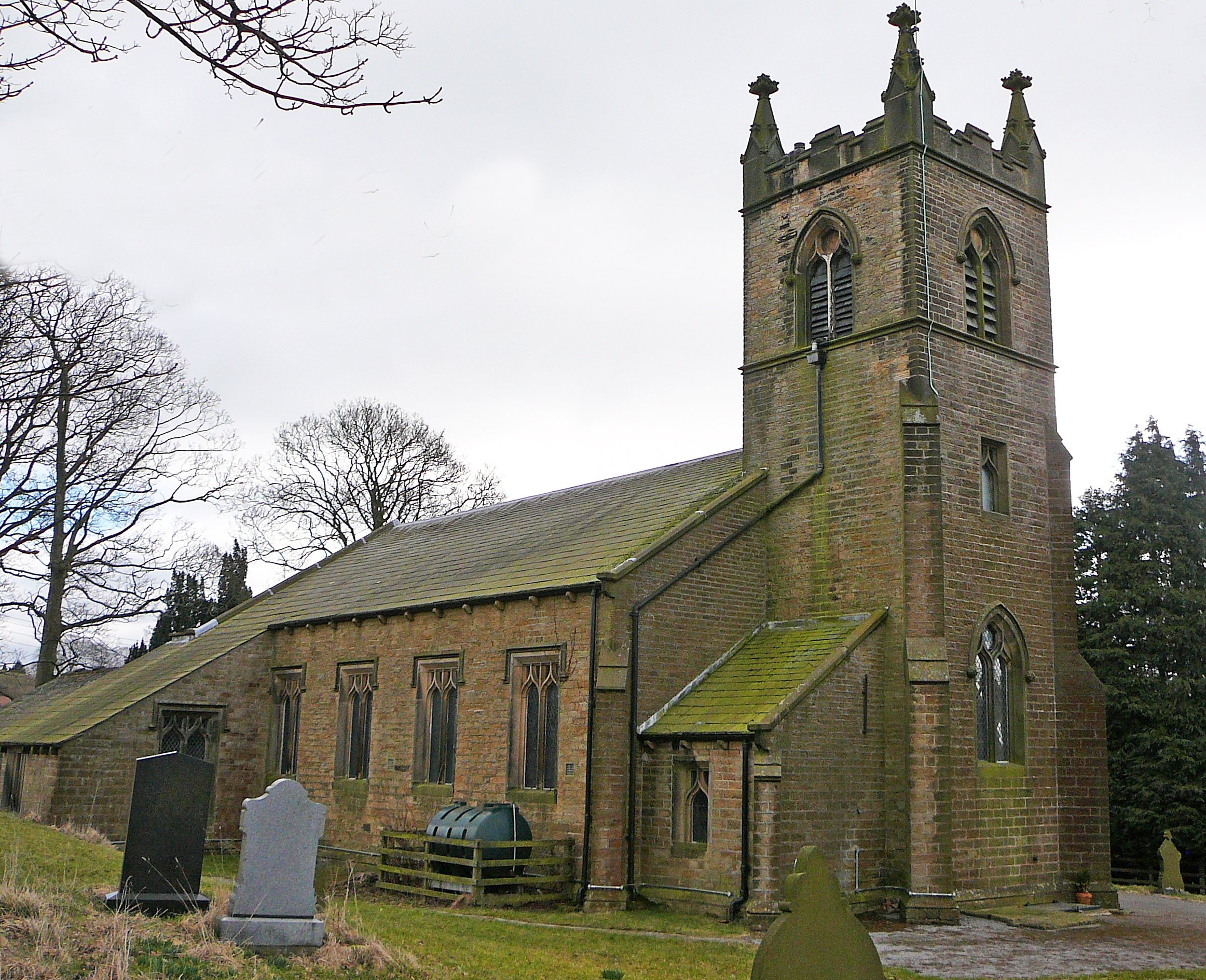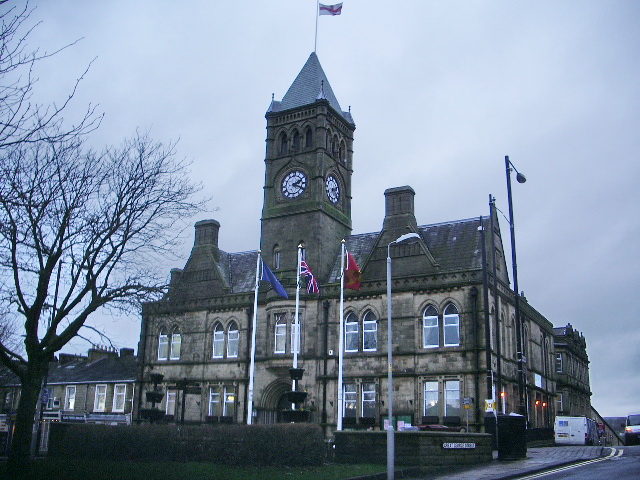|
Crosshills
Cross Hills is a village in the Craven district of North Yorkshire, England that is situated halfway between Skipton and Keighley. The village is at the centre of a built-up area that includes the adjoining settlements of Glusburn, Kildwick, Eastburn and Sutton-in-Craven. Cross Hills is the newer part of the civil parish now called Glusburn and Cross Hills, historically known as Glusburn. Geography Cross Hills is in Airedale at a point where the River Aire bends east from its north–south course. The village lies on the south bank of the river just above the flood plain, which is wholly agricultural. As its name implies, Cross Hills is surrounded by the hills of the eastern Pennines including Steeton Moor (south-east), Cowling Moor (south-west), White Hill (north-west) and Kildwick Moor (north-east). There are views along the Aire Valley itself to the north and east. Rombalds Moor, between Silsden and Ilkley, is about six miles east of Cross Hills. Skipton is about four mil ... [...More Info...] [...Related Items...] OR: [Wikipedia] [Google] [Baidu] |
Kildwick And Crosshills Railway Station
Kildwick and Crosshills sic.html"_;"title="'sic">'sic''was_a_railway_station_off_Station_Road_in_Cross_Hills.html" ;"title="sic">'sic''.html" ;"title="sic.html" ;"title="'sic">'sic''">sic.html" ;"title="'sic">'sic''was a railway station off Station Road in Cross Hills">sic">'sic''.html" ;"title="sic.html" ;"title="'sic">'sic''">sic.html" ;"title="'sic">'sic''was a railway station off Station Road in Cross Hills, North Yorkshire (formerly West Riding of Yorkshire), England. It served the villages of Cross Hills, Cowling, Craven, Cowling, Glusburn, Kildwick and Sutton-in-Craven. History The station was opened in late 1847Binns, p. 8 by the Leeds and Bradford Extension Railway, located between Cononley and Steeton and Silsden. The latter, which is about two miles from both Cross Hills and Kildwick, is now the nearest station to all five villages. The station was originally called Kildwick,Dewick, Map 21 then Kildwick and Cross Hills.Binns, p. 12 The original st ... [...More Info...] [...Related Items...] OR: [Wikipedia] [Google] [Baidu] |
Kildwick
Kildwick, or Kildwick-in-Craven, is a village and civil parish of the district of Craven in North Yorkshire, England. It is situated between Skipton and Keighley and had a population of 191 in 2001, rising slightly to 194 at the 2011 census. Kildwick is a landmark as where the major road from Keighley to Skipton crosses the River Aire. The village's amenities include a primary school, church and public house. History Etymology The first known documentation of Kildwick's name is as ''Childeuuic'' in the ''Domesday Book''. In Latin, the digraph ch is pronounced /kʰ/ not /tʃ/ so its pronunciation was the same as it is now. The meaning of its name depends on whether it was named by the conquering Vikings or earlier in Old English. However, no evidence of the latter is known, and other place names nearby are predominantly Old Norse. *Kild. In Old Danish ''kilde'' means either a spring like in Keld to the north, or a large smooth body of water. ''Kelda'' has its roots in ... [...More Info...] [...Related Items...] OR: [Wikipedia] [Google] [Baidu] |
Steeton And Silsden Railway Station
Steeton and Silsden railway station serves the village of Steeton and the town of Silsden in West Yorkshire, England. It is situated closer to Steeton than to Silsden, and is on the Airedale Line. The station, and all trains serving it, are operated by Northern. History Steeton & Silsden was opened by the Leeds and Bradford Extension Railway in December 1847, and was later re-sited in march 1892. The station was closed on 20 March 1965 (a victim of the Beeching Axe) but reopened in 1990. The current (staggered) station platforms built by British Rail are located on the site of the old A6068 level crossing, which was replaced by the current road bridge in 1988 as part of the Aire Valley Trunk Road project. Until its closure, both platforms were situated to the north of the former crossing, although the original station building (which survives as a private residence) was located on the Keighley side (south of the current northbound platform). Because the station is the fi ... [...More Info...] [...Related Items...] OR: [Wikipedia] [Google] [Baidu] |
Sutton-in-Craven
Sutton-in-Craven is a village, electoral ward and (as just Sutton) a civil parish in the Craven district of North Yorkshire, England that is situated in the Aire Valley between Skipton and Keighley. Historically part of the West Riding of Yorkshire, in 2001 the population was 3,480, increasing to 3,714 at the Census 2011. The village is adjacent to Glusburn and Cross Hills, but although these three effectively form a small town, Sutton village maintains its distinct identity. History The village existed before 1086 as "Sutun": listed in the ''Domesday Book''. The landowner then was Ravenkeld who was taxed on 240 acres (100 hectares) of ploughland. But lands were then given by the Norman crown to its compatriots: Robert de Romille followed by Edmund de Boyvill and then Adam de Copley. In the 14th century, the village was known as Sutton-in-Ayrdale but became Sutton-in-Craven in 1620. In the late 17th century Sutton-in-Craven became part of the ancient parish of Kildwick so a ... [...More Info...] [...Related Items...] OR: [Wikipedia] [Google] [Baidu] |
Malsis School
Malsis School located at a mansion known as Malsis Hall in the village of Crosshills, in North Yorkshire, England, was a co-educational independent Independent or Independents may refer to: Arts, entertainment, and media Artist groups * Independents (artist group), a group of modernist painters based in the New Hope, Pennsylvania, area of the United States during the early 1930s * Independ ... pre-prep and preparatory school for pupils aged 3 to 13 years. The school was founded in 1920, and closed due to falling pupil numbers in 2014. Facilities at the school included a 3 km mountain bike trail, 9-hole golf course, swimming pool, all weather pitch, rifle range, 40 acres of grounds and a Chapel with windows by the renowned stained-glass artist John Piper. The school closed on 10 December 2014, when the final assembly started at 11 am and concluded at 1 pm. The next day the school trust went into administration with Ernst & Young of Leeds. The school's ass ... [...More Info...] [...Related Items...] OR: [Wikipedia] [Google] [Baidu] |
Midland Railway
The Midland Railway (MR) was a railway company in the United Kingdom from 1844. The Midland was one of the largest railway companies in Britain in the early 20th century, and the largest employer in Derby, where it had its headquarters. It amalgamated with several other railways to create the London, Midland and Scottish Railway at grouping in 1922. The Midland had a large network of lines emanating from Derby, stretching to London St Pancras, Manchester, Carlisle, Birmingham, and the South West. It expanded as much through acquisitions as by building its own lines. It also operated ships from Heysham in Lancashire to Douglas and Belfast. A large amount of the Midland's infrastructure remains in use and visible, such as the Midland main line and the Settle–Carlisle line, and some of its railway hotels still bear the name '' Midland Hotel''. History Origins The Midland Railway originated from 1832 in Leicestershire / Nottinghamshire, with the purpose of serving the needs o ... [...More Info...] [...Related Items...] OR: [Wikipedia] [Google] [Baidu] |
Bus Service
Public transport bus services are generally based on regular operation of transit buses along a route calling at agreed bus stops according to a published public transport timetable. History of buses Origins While there are indications of experiments with public transport in Paris as early as 1662, there is evidence of a scheduled "bus route" from Market Street in Manchester to Pendleton in Salford UK, started by John Greenwood in 1824. Another claim for the first public transport system for general use originated in Nantes, France, in 1826. Stanislas Baudry, a retired army officer who had built public baths using the surplus heat from his flour mill on the city's edge, set up a short route between the center of town and his baths. The service started on the Place du Commerce, outside the hat shop of a M. Omnès, who displayed the motto ''Omnès Omnibus'' (Latin for "everything for everybody" or "all for all") on his shopfront. When Baudry discovered that passengers ... [...More Info...] [...Related Items...] OR: [Wikipedia] [Google] [Baidu] |
Lothersdale
Lothersdale is a small village and civil parish in the Craven district of North Yorkshire, England, near Skipton and within the triangle formed by Skipton, Cross Hills and Colne. It is a small community of about 200 houses but local amenities include a park, church, chapel, pub, village hall, clubhouse and (Ofsted 'Outstanding') primary school. The Pennine Way runs through it. The Parish Council has five elected members and meets on the second Thursday of each month (except for August) at 7.30 p.m. It decides on the amount of local taxes (the precept), planning applications, and numerous other issues pertaining to local life. No house in the village is connected to mains gas or water and it has very limited mobile and broadband connection. This has had the effect of limiting the amount of development that has taken place and gives the village an unspoilt atmosphere. It has also caused conflict for more than 25 years over the ownership rights of water from various springs. ... [...More Info...] [...Related Items...] OR: [Wikipedia] [Google] [Baidu] |
Cononley
Cononley ( or ) is a village and civil parish in the Craven district of North Yorkshire, England. Historically part of the West Riding of Yorkshire, Cononley is in the Aire Valley south of Skipton and with an estimated population of 1,080 (2001 est.), measured at 1,172 at the 2011 census. It is situated west of the A629 road with access to Skipton, Keighley. Also joined to the Leeds-Carlisle railway, the village has commuter access to Leeds and Bradford. The village is served by Cononley railway station. History and information The origin of the settlement There is evidence that people first settled around Cononley in the Bronze and Iron Ages. The Domesday Book contains only a brief mention of Cononley, but the settlement's name had probably originated several centuries earlier. The ending 'ley' refers to a clearing in the then wooded Aire valley and is shared with other Airedale communities. The first part of the name is derived from either a personal name or a river ... [...More Info...] [...Related Items...] OR: [Wikipedia] [Google] [Baidu] |
Colne
Colne () is a market town and civil parish in the Borough of Pendle in Lancashire, England. Located northeast of Nelson, north-east of Burnley, east of Preston and west of Leeds. The town should not be confused with the unrelated Colne Valley around the River Colne near Huddersfield in West Yorkshire. Colne is close to the southern entrance to the Aire Gap, the lowest crossing of the Pennine watershed. The M65 terminates west of the town and from here two main roads take traffic onwards towards the Yorkshire towns of Skipton (A56) and Keighley (A6068). Colne railway station is the terminus of the East Lancashire railway line. Colne adjoins the Pendle parishes of Foulridge, Laneshaw Bridge, Trawden Forest, Nelson, Barrowford and Blacko. History Settlement in the area can be traced back to the Stone Age. A Mesolithic camp site, a Bronze Age burial site and stone tools from the Bronze and Stone Ages have been discovered at nearby Trawden. There are also the remains of an I ... [...More Info...] [...Related Items...] OR: [Wikipedia] [Google] [Baidu] |
Lund's Tower
Lund's Tower is a stone-built folly situated to the south-west of the North Yorkshire village of Sutton-in-Craven. It is also known as Cowling Pinnacle, Sutton Pinnacle, the Ethel Tower, the Jubilee Tower or, in conjunction with the nearby Wainman's Pinnacle, the pair are referred to as the Salt and Pepper Pots. It is listed in the National Heritage List for England at Grade II. History James Lund (1829–1903) commissioned the Keighley architectural firm of R. B. Broster & Sons to design the tower, which was built in 1887. Different reasons have been given for why Lund wanted the folly built: local residents refer to it as the Ethel Tower, believing it was constructed either to celebrate the birth of Lund's daughter Ethel – or her 21st birthday; others refer to it as the Jubilee Tower, believing it commemorated the 1887 jubilee of Queen Victoria. It is also known as Sutton Pinnacle. Lund was the son of William Lund, the owner of William Lund & Son, a large textile manufactu ... [...More Info...] [...Related Items...] OR: [Wikipedia] [Google] [Baidu] |
Battle Of Waterloo
The Battle of Waterloo was fought on Sunday 18 June 1815, near Waterloo, Belgium, Waterloo (at that time in the United Kingdom of the Netherlands, now in Belgium). A French army under the command of Napoleon was defeated by two of the armies of the Seventh Coalition. One of these was a British-led coalition consisting of units from the United Kingdom of Great Britain and Ireland, United Kingdom, the Netherlands, Kingdom of Hanover, Hanover, Duchy of Brunswick, Brunswick, and Duchy of Nassau, Nassau, under the command of the Duke of Wellington (referred to by many authors as ''the Anglo-allied army'' or ''Wellington's army''). The other was composed of three corps of the Kingdom of Prussia, Prussian army under the command of Field Marshal Gebhard Leberecht von Blücher, von Blücher (the fourth corps of this army fought at the Battle of Wavre on the same day). The battle marked the end of the Napoleonic Wars. The battle was contemporaneously known as the Battle of Mont Saint-J ... [...More Info...] [...Related Items...] OR: [Wikipedia] [Google] [Baidu] |








.jpg)
